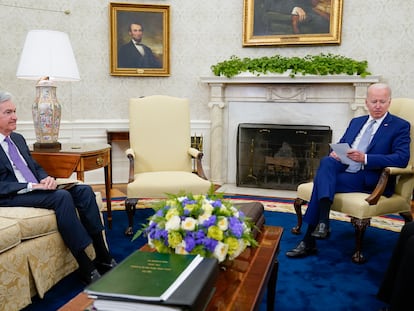Faith, family and hatred of progressive policies: The power of Latino evangelicals spreads across the United States
The Christian faith among Latinos is on the rise as the country becomes less and less religious. Fueled by new immigrants and a community in search of belonging, it points to the growing conservatism among the traditionally Democrat voter base
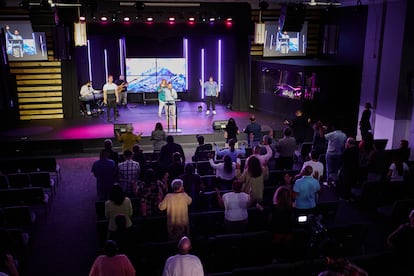

A Sunday sermon in a Latino evangelical church in the United States takes place between moving songs with a live band and speeches from a pastor who uses familiar, even colloquial, language. It is not a particularly solemn event. The only thing that makes it similar to Mass is the constant mention of Jesus. Empirical evidence says that this is a good for the church’s goal, which is one of the foundations of evangelism: increasing followers.
While other religious denominations are losing members, the Latino evangelical churches are growing at a remarkable pace. It is a phenomenon that is going a little under the radar — religion in general is of less and less interest — but that, in a planned way, is changing the balance of religion’s immense power in the United States. It is also fragmenting the Latin electorate, traditionally closely aligned with Democrats: amid the rise of evangelism, these voters are becoming increasingly conservative.

At the New Life church in Chicago, the sermons are in Spanish and its most important goal is ensuring that all newcomers return to the church. There is a carefully designed protocol because people decide if they are going to come back in the first five minutes, says Pastor Jaro Medina one Sunday morning in mid-April.
At the door, there is someone welcoming everyone in with a warm smile and “blessings.” Once inside the church — a three-story building, which if it were not for the immense cross on the façade, could be just an old theater in a neighborhood that has seen better days — the new arrivals are offered coffee, asked how they are and listened attentively to as they share any hardships they may be suffering. Then, the sermon kicks off as if it were a party: there are 15 minutes of music, a kind of modern, pop, Latin gospel. The rhythm gets the congregants out of their chairs and dancing. The church is carpeted like a convention center and has giant screens, which the people look at, as they raise their arms in ecstasy and follow the lyrics, as if they were in a collective karaoke.
Pastor Jaro, a 40-year-old Puerto Rican who has been leading this congregation for a decade, has seen and encouraged that growth himself. “In 2014 things were very different. We were opening the third Sunday service. We started the fourth when the pandemic hit. It hit us hard. But when the restrictions were eased, and the border began to open, many immigrants entered,” he explains between sermons in his parish, which now has around 500 members. Pastor Jaro is part of a group that has more than 5,000 followers, which is considered small.
Pastor Jaro’s experience is reflected in the data, but it is important to dig a little deeper. Between 2008 and 2022, the percentage of Latinos who identify as evangelical has remained stable at around 25%. In the rest of the groups, the figure has fallen, most notably among the white population, where it has dropped from 33% to 25%. The growth comes amid the demographic changes in the United States. In 2008, there were around 50 million Latinos in the United States, now there are around 65 million and by 2050 there will be almost 100 million. In other words, that 25% represents more people every day.
Furthermore, trends indicate that this 25% — which has remained stable over the last 15 years — is also increasing. Driving this growth are two specific groups: immigrants, 22% of whom identified as evangelical in 2008, a figure that rose to 32% by 2022; and second and third generation Latinos, where the percentage of evangelicals rose from 23% to 29% and from 27% to 31% respectively, in the same period.
Given Latino evangelicals are also having more children than the national average, it is foreseeable that within a few years the Latino religious panorama, and even the broader one, will be dominated by this amalgam of Christian denominations known as evangelicals; and that its political agenda will play an increasingly important role.
Evangelicals have no qualms about being clear that their goal is to grow their number of followers. It is considered as a matter of religious conviction: when the end comes, only those who have accepted Jesus in their hearts will be saved. And if it is in their hands to save souls, there will be no idle hands. The entire community works together in this mission and the process to retain followers extends far beyond the first minutes. Members follow up with newcomers the week after they first attend church. They call them up to three different days to ask them how they are going, to invite them to dinner, to make them feel like they are already a brother or sister.
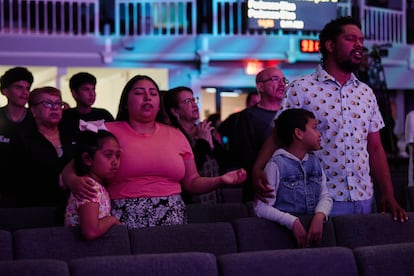
This is precisely what Lizbeth Rodríguez says after listening carefully to Pastor Jaro. “For me, the church gives me family, it gives me this companionship… Although we are going through things, for example my husband passed away, here I have a sister or a brother who helps me in this journey and encourages me, gives me encouragement, visits me. They are family in this world.”
For migrants, arriving in a new country after a painful journey and with hardly any English, this somewhat theatrical kindness is seen from a different perspective. In these churches, they are considered family from the first greeting, the accents remind them of home, as do the food and affection. For many it is an overwhelming sensation. It doesn’t matter how much the Bible and Jesus have been in their previous lives. Now, more than a thousand miles north, perhaps it is a reminder of their roots or a sanctuary to keep demons at bay. These migrants are also especially willing to listen if it comes with a hot dinner.
There is yet another attraction, in the form of an idea, that paves the way for the other notions that make up the evangelical political imagination to be received. It is the idea of personal progress, quantifiable and linked to economic prosperity. In these churches, poverty is not a virtue. For people who have largely grown up with poverty and in many cases are fleeing from it, this message finds fertile ground. Suddenly, Jesus is, in addition to being a martyr for humanity, a believer and guardian of the American dream. In this way, the defense of the family, the rejection of vices — a huge umbrella that includes any behavior considered reprehensible, from the consumption of alcohol and other drugs, to the excessive use of social media — fit neatly into the picture. It’s a picture in which the state is painted as the protector of moral depravity for its support of progressive policies.
With these policies perceived as a threat to evangelical values, the church has strengthened its conviction that it has the solutions to the most pressing questions facing the United States. “People come with questions and we have to be able to answer them. And if we don’t know the answer, we have to find it... There are questions about the future. What’s coming now? Who should we trust? Who shouldn’t we trust?” explains Pastor Daniel Matos, who has led the Agape Christian church in Chicago for more than four decades.
Matos — who was also born in Puerto Rico, but has lived in Chicago since he was three — is the Midwest regional director of the National Hispanic Christian Leadership Conference (NHCLC), the leading association of Latino evangelism in the country, which brings together more than 40,000 churches. The NHCLC actively supports the creation of new congregations — Pastor Matos says it is the Amazon for new churches, offering them everything they may need — and is not shy when it comes to deploying its political power.
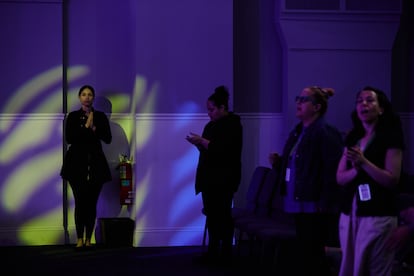
The 2018 NHCLC vision statement sheds even more light on the political and social agenda of Latino evangelical churches. Is central mission includes reforming culture by creating influencers in all spheres of society and the market, transforming the image of evangelism from “angry white evangelicals who oppose everything” to a multiethnic community, and building a “firewall against moral relativism, spiritual apathy, cultural decadence, and ecclesiastical lukewarmness while simultaneously elevating biblical marriage, championing life and protecting religious liberty.” It’s the usual ultra-conservatism disguised as a “multiethnic community” to make it slightly more digestible.
The comments made by NHCLC leader Samuel Rodríguez — who is a recurring guest on the far-right news network Fox and a figure within the religious lobby in Washington — make it clear that Latino evangelism is flexing its political muscle. It has built on the foundations of white evangelicalism, which has had an enormous influence on both Republican and Democrat administrations. This influence rose to the fore in 2016, with the evangelical community’s mass support for Donald Trump; who returned the favor by appointing three justices to create the most conservative Supreme Court in decades — a move that culminated with overturning of the federal right to abortion in 2022.
In the November election and in the elections to come, it remains to be seen exactly what a much more powerful Latino evangelical lobby will seek. Undoubtedly, abortion will remain a central battleground, with a total ban the ultimate goal. But that may be aiming for too much, in the current landscape openly committing to ban abortion would be electoral suicide.
Then there are the broader cultural battles, in which the collective has been supporting the conservative side. It could follow the model of Florida, where the Latino evangelical community has perhaps the greatest presence and sway. Under Florida Governor Ron DeSantis, the state has passed laws banning LGBTQ+ content in schools, introduced a six-week ban on abortion, one of the most restrictive in the country, and also banned more books than any other state. The big question, however, is what position Latino evangelicals will take when it comes to immigration. While they support legal immigration, they do not reject the undocumented migrants who come in search of a better life in the United States — many of whom are their new members.
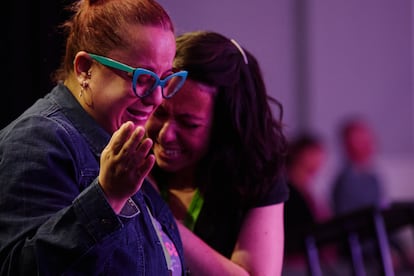
In any case, when sermons ring out in the halls of the thousands of Latino evangelical churches in the country, there is no talk of politics. It is a time to feel part of a community and to be faithful to God’s teachings. The average congregant is not necessarily very politic, for them, the church is the reason they were able to save their marriage, give up alcohol or adapt to a new country. However, these voters trust in the pastor’s word. But votes mean nothing, if there is not a lot of them, and the Latino evangelicals’ plan to grow is in full swing.
Sign up for our weekly newsletter to get more English-language news coverage from EL PAÍS USA Edition
Tu suscripción se está usando en otro dispositivo
¿Quieres añadir otro usuario a tu suscripción?
Si continúas leyendo en este dispositivo, no se podrá leer en el otro.
FlechaTu suscripción se está usando en otro dispositivo y solo puedes acceder a EL PAÍS desde un dispositivo a la vez.
Si quieres compartir tu cuenta, cambia tu suscripción a la modalidad Premium, así podrás añadir otro usuario. Cada uno accederá con su propia cuenta de email, lo que os permitirá personalizar vuestra experiencia en EL PAÍS.
¿Tienes una suscripción de empresa? Accede aquí para contratar más cuentas.
En el caso de no saber quién está usando tu cuenta, te recomendamos cambiar tu contraseña aquí.
Si decides continuar compartiendo tu cuenta, este mensaje se mostrará en tu dispositivo y en el de la otra persona que está usando tu cuenta de forma indefinida, afectando a tu experiencia de lectura. Puedes consultar aquí los términos y condiciones de la suscripción digital.
More information
Archived In
Últimas noticias
Welcome to the post-religion era: The idea of Christianity as the absolute truth has become obsolete
‘I thought you would like it’: The risky sexual practice popularized by TV shows and TikTok
The digitalization of tourism: ‘They promise experiences and gave us the worst possible one’
Mexican peso defies uncertainty with forecasts of a new period of stability in 2026
Most viewed
- Sinaloa Cartel war is taking its toll on Los Chapitos
- Reinhard Genzel, Nobel laureate in physics: ‘One-minute videos will never give you the truth’
- Oona Chaplin: ‘I told James Cameron that I was living in a treehouse and starting a permaculture project with a friend’
- Why the price of coffee has skyrocketed: from Brazilian plantations to specialty coffee houses
- Silver prices are going crazy: This is what’s fueling the rally
